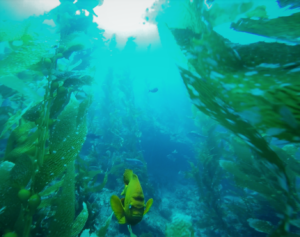Crystal Cove’s Underwater Forest

Millions of visitors each year explore Crystal Cove State Park’s tidepools, beaches, and backcountry, but only a fraction of them discover the hidden world swaying beneath the waves. Crystal Cove contains over 1,000 acres an offshore underwater park with one of the most biodiverse marine ecosystems in the world: the kelp forest. Kelp forests are found predominantly on the eastern Pacific Ocean, from Alaska down to Baja. Giant kelp, the species that makes up the forests here in Southern California, is the world’s largest species of marine algae and can create dense forests up to 100 feet tall. This single species is home to a diverse ecosystem of over 1,000 different plants and animals.
Giant kelp is considered an ecosystem engineer, because its presence creates an entire ecosystem. The holdfasts that anchor the kelp to rocky reefs provide shelter and food for countless invertebrates such as brittle stars, sea urchins, and marine snails. Fish such as sheepshead and garibaldi feed on those invertebrates and seek shelter from predators among the blades of kelp. Seals, sea otters, pelagic birds, and even gray whales depend on the kelp forest in some way for food or protection.
Kelp forests are complex and incredibly fragile ecosystems, and they rely on a delicate balance of ocean chemistry and species composition. Changes in temperature, or the loss of a single species can cause entire communities to collapse. Beginning in the 1960s, Southern California’s kelp forest populations declined rapidly. Urban runoff, overharvesting of fish, lobster, and abalone, and the local extinction of sea otter populations caused 80% of Southern California’s kelp forests to disappear by the 1990s.
Today, kelp forests have returned to Orange County thanks to restoration efforts from 2005-2007 by volunteer divers. To ensure they survive for years to come, our kelp forests are protected by the Marine Life Protection Act enacted in 2012. Crystal Cove’s offshore underwater park was designated as a Marine Conservation Area and fishing is tightly regulated. The health of our kelp forests is currently being monitored by high school students aboard Crystal Cove Conservancy’s Marine Protected Area Citizen Science Cruise. Students collect data on the diversity of fish and plankton species, water quality, and ocean chemistry. Data is collected over a period of time so students can track changes and learn about normal and abnormal cycles or indicators. Though many threats still persist, with consistent long-term monitoring, we can catch problems early, and ensure our kelp forests are here to stay.
